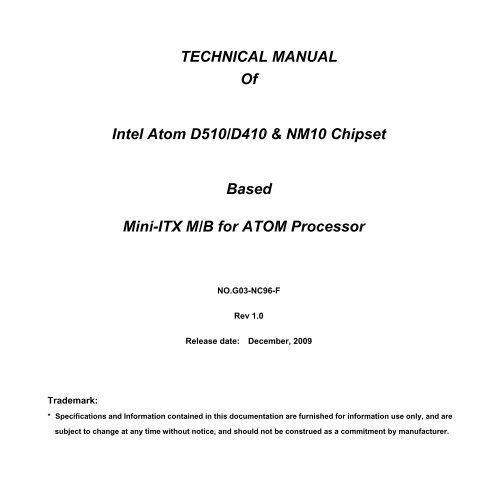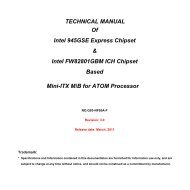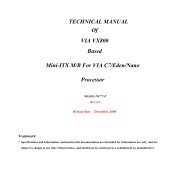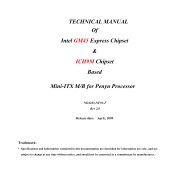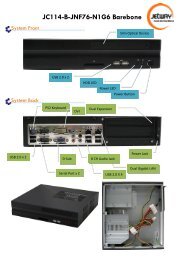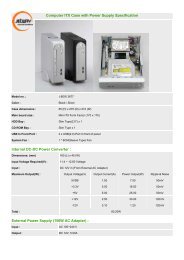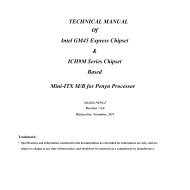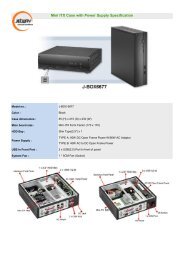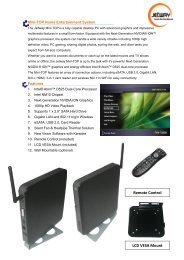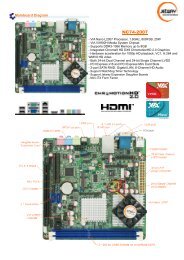TECHNICAL MANUAL Of Intel Atom D510/D410 ... - Jetway Computer
TECHNICAL MANUAL Of Intel Atom D510/D410 ... - Jetway Computer
TECHNICAL MANUAL Of Intel Atom D510/D410 ... - Jetway Computer
Create successful ePaper yourself
Turn your PDF publications into a flip-book with our unique Google optimized e-Paper software.
<strong>TECHNICAL</strong> <strong>MANUAL</strong><br />
<strong>Of</strong><br />
<strong>Intel</strong> <strong>Atom</strong> <strong>D510</strong>/<strong>D410</strong> & NM10 Chipset<br />
Based<br />
Mini-ITX M/B for ATOM Processor<br />
NO.G03-NC96-F<br />
Rev 1.0<br />
Release date: December, 2009<br />
Trademark:<br />
* Specifications and Information contained in this documentation are furnished for information use only, and are<br />
subject to change at any time without notice, and should not be construed as a commitment by manufacturer.
Environmental Protection Announcement<br />
Do not dispose this electronic device into the trash while discarding. To minimize<br />
pollution and ensure environment protection of mother earth, please recycle.<br />
i
TABLE OF CONTENT<br />
ENVIRONMENTAL SAFETY INSTRUCTION ........................................................................... iii<br />
USER’S NOTICE ....................................................................................................................... iv<br />
<strong>MANUAL</strong> REVISION INFORMATION ....................................................................................... iv<br />
ITEM CHECKLIST ..................................................................................................................... iv<br />
CHAPTER 1 INTRODUCTION OF THE MOTHERBOARD<br />
1-1 FEATURE OF MOTHERBOARD ................................................................................ 1<br />
1-2 SPECIFICATION ......................................................................................................... 2<br />
1-3 LAYOUT DIAGRAM .................................................................................................... 3<br />
CHAPTER 2 HARDWARE INSTALLATION<br />
2-1 JUMPER SETTING ..................................................................................................... 7<br />
2-2 CONNECTORS AND HEADERS ................................................................................ 11<br />
2-2-1 CONNECTORS ............................................................................................. 11<br />
2-2-2 HEADERS ..................................................................................................... 12<br />
CHAPTER 3 INTRODUCING BIOS<br />
3-1 ENTERNING SETUP ................................................................................................... 19<br />
3-2 GETTING HELP .......................................................................................................... 19<br />
3-3 THE MAIN MENU ........................................................................................................ 19<br />
3-4 STANDARD BIOS FEATURES .................................................................................. 21<br />
3-5 ADVANCED BIOS FEATURES .................................................................................. 25<br />
3-5-1 CPU FEATURE ............................................................................................... 25<br />
3-6 ADVANCED CHIPSET FEATURES ........................................................................... 25<br />
3-7 INTEGRATED PHERIPHRALS .................................................................................. 27<br />
3-7-1 ONBOARD SATA FUNCTION ........................................................................ 27<br />
3-7-2 ONBOARD DEVICE FUNCTION ..................................................................... 28<br />
3-7-3 ONBOARD SUPER IO FUNCTION ................................................................. 29<br />
3-8 POWER MANAGEMENT SETUP ............................................................................... 30<br />
3-9 PNP/PCI CONFIGURATIONS ..................................................................................... 31<br />
3-10 PC HEALTH STATUS ................................................................................................. 32<br />
3-11 MISCELLANEOUS CONTROL ................................................................................... 33<br />
3-12 PASSWORD SETTING ............................................................................................... 34<br />
3-13 LOAD OPTIMIZED /STANDARDDEFAULTS ............................................................ 35<br />
3-14 SAVE AND EXIT SETUP/EXIT WITHOUT SAVING ................................................... 35<br />
ii
Environmental Safety Instruction<br />
• Avoid the dusty, humidity and temperature extremes. Do not place the product in<br />
any area where it may become wet.<br />
• 0 to 60 centigrade is the suitable temperature. (The figure comes from the request<br />
of the main chipset)<br />
• Generally speaking, dramatic changes in temperature may lead to contact<br />
malfunction and crackles due to constant thermal expansion and contraction from<br />
the welding spots’ that connect components and PCB. <strong>Computer</strong> should go<br />
through an adaptive phase before it boots when it is moved from a cold<br />
environment to a warmer one to avoid condensation phenomenon. These water<br />
drops attached on PCB or the surface of the components can bring about<br />
phenomena as minor as computer instability resulted from corrosion and oxidation<br />
from components and PCB or as major as short circuit that can burn the<br />
components. Suggest starting the computer until the temperature goes up.<br />
• The increasing temperature of the capacitor may decrease the life of computer.<br />
Using the close case may decrease the life of other device because the higher<br />
temperature in the inner of the case.<br />
• Attention to the heat sink when you over-clocking. The higher temperature may<br />
decrease the life of the device and burned the capacitor.<br />
iii
USER’S NOTICE<br />
COPYRIGHT OF THIS <strong>MANUAL</strong> BELONGS TO THE MANUFACTURER. NO PART OF THIS <strong>MANUAL</strong>,<br />
INCLUDING THE PRODUCTS AND SOFTWARE DESCRIBED IN IT MAY BE REPRODUCED, TRANSMITTED<br />
OR TRANSLATED INTO ANY LANGUAGE IN ANY FORM OR BY ANY MEANS WITHOUT WRITTEN<br />
PERMISSION OF THE MANUFACTURER.<br />
THIS <strong>MANUAL</strong> CONTAINS ALL INFORMATION REQUIRED TO USE THIS MOTHER-BOARD SERIES AND WE<br />
DO ASSURE THIS <strong>MANUAL</strong> MEETS USER’S REQUIREMENT BUT WILL CHANGE, CORRECT ANY TIME<br />
WITHOUT NOTICE. MANUFACTURER PROVIDES THIS <strong>MANUAL</strong> “AS IS” WITHOUT WARRANTY OF ANY<br />
KIND, AND WILL NOT BE LIABLE FOR ANY INDIRECT, SPECIAL, INCIDENTAL OR CONSEQUENTIAL<br />
DAMAGES (INCLUDING DAMAGES FOR LOSS OF PROFIT, LOSS OF BUSINESS, LOSS OF USE OF DATA,<br />
INTERRUPTION OF BUSINESS AND THE LIKE).<br />
PRODUCTS AND CORPORATE NAMES APPEARING IN THIS <strong>MANUAL</strong> MAY OR MAY NOT BE<br />
REGISTERED TRADEMARKS OR COPYRIGHTS OF THEIR RESPECTIVE COMPANIES, AND THEY ARE<br />
USED ONLY FOR IDENTIFICATION OR EXPLANATION AND TO THE OWNER’S BENEFIT, WITHOUT<br />
INTENT TO INFRINGE.<br />
Manual Revision Information<br />
Reversion Revision History Date<br />
1.0 First Edition December, 2009<br />
Item Checklist<br />
Motherboard<br />
Motherboard User’s Manual<br />
DVD for motherboard utilities<br />
Cable(s)<br />
I/O Back panel shield<br />
iv
Chapter 1<br />
Introduction of the Motherboard<br />
1-1 Feature of motherboard<br />
• <strong>Intel</strong> <strong>Atom</strong> <strong>D510</strong>/<strong>D410</strong> and NM10 chipset.<br />
• Onboard <strong>Intel</strong> <strong>Atom</strong> CPU, with low power consumption never denies high<br />
performance.<br />
• Support CPU CLK 166 MHz<br />
• Support DDRII DIMM 667/800 up to 8GB.<br />
• Support PCI slot and mini-PCIE slot<br />
• Onboard Realtek RTL 8111DL Gigabit Ethernet LAN.<br />
• Integrated ALC662 6-channel HD audio CODEC.<br />
• Support USB2.0 data transport demands.<br />
• Support RS232/422/485 and watchdog.<br />
1
1-2 Specification<br />
Spec<br />
Design<br />
Chipset<br />
Embedded CPU<br />
Memory Socket<br />
Expansion Slot<br />
Integrate IDE<br />
LAN<br />
Audio<br />
BIOS<br />
Multi I/O<br />
Description<br />
• Mini-ITX form factor 4 layers ; PCB size: 17.0x17.0cm<br />
• NM10 Chipset<br />
• <strong>Intel</strong> <strong>Atom</strong> <strong>D510</strong>/<strong>D410</strong> CPU<br />
• 240-pin DDRII DIMM slot x2<br />
• Support DDRII 667/800 MHz DDRII memory modules<br />
• Expandable to 8 GB<br />
• 32-bit PCI slot x 1<br />
• Mini-PCIE slot x1<br />
• One PCI IDE controller that supports PCI Bus Mastering,<br />
ATA PIO/DMA and the ULTRA DMA 100/66 functions that<br />
deliver the data transfer rate up to 100 MB/s<br />
• Integrated Realtek RTL8111DL PCI-E Gigabit LAN<br />
• Support Fast Ethernet LAN function of providing<br />
10Mb/100Mb/1000Mb Ethernet data transfer rate<br />
• ALC662 6-channel Audio Codec integrated<br />
• Audio driver and utility included<br />
• AMI 8MB DIP Flash ROM<br />
• PS/2 keyboard connector x1<br />
• PS/2 mouse connector x1<br />
• Serial port connector x1<br />
• VGA port connector x1<br />
• Parallel port Connector x1<br />
• USB port connector x4 USB header x2<br />
• RJ-45 LAN connector x1<br />
• Audio connector x1 (Line-in, Line-out, MIC)<br />
• SATAII Connector x4<br />
• Front panel audio header x1<br />
• Serial port header x1<br />
• RS232/422/RS485 header x1<br />
2
1-3 Layout Diagram<br />
• LVDS header x1<br />
• LVDS Inverter x1<br />
• GPIO header x1<br />
PS/2<br />
Mouse Port<br />
Parallel Port<br />
RJ-45 LAN Connector<br />
Line-IN<br />
Line-OUT<br />
DC12V<br />
MIC-IN<br />
COM<br />
PS/2<br />
Port<br />
Keyboard Port<br />
VGA Port<br />
USB Ports<br />
3
CPU FAN1<br />
SFAN2<br />
DC12V Power<br />
Connector<br />
Keyboard & Mouse<br />
Connector<br />
JP1<br />
Inverter<br />
JP4<br />
LVDS Header<br />
SATA Power<br />
Connector<br />
JP6<br />
JP2<br />
Parallel Port<br />
over<br />
Serial Port & VGA Port<br />
JP7<br />
SFAN1<br />
Inter CPU<br />
DDRII DIMM Slot x2<br />
(DDRII 800 / DDRII 667)<br />
USB Ports<br />
RJ-45 over USB<br />
Ports<br />
Audio Connector<br />
ALC662 Audio Codec<br />
JP8<br />
CDIN<br />
Audio Header<br />
for front Panel<br />
GPIO Header<br />
JP5<br />
<strong>Intel</strong> NM 10 Chipset<br />
COM2 Header<br />
JBAT<br />
Mini-PCIE Slot<br />
TX-RX<br />
8 Mbit DPI Flash Rom BIOS<br />
JP9<br />
USB1/2 Header<br />
PCI slot<br />
SATAII<br />
Connector (1, 2)<br />
IDE Harddisk<br />
Header<br />
SATAII<br />
Connector (3, 4)<br />
Power LED Header<br />
Speaker Header<br />
Front Panel Header<br />
4
Jumper<br />
Jumper Name Description<br />
JP1 K/B, USB Power On Function Setting 3-pin Block<br />
JP5 USB 1/2 Power On Function Setting 3-pin Block<br />
JBAT1 CMOS RAM Clear Function Setting 2-pin Block<br />
JP2 LVDS PVCC 5V/3.3V Select 3-pin Block<br />
JP4 Inverter12V/5V Select 3-pin Block<br />
JP9 Mini PCI-E Power VCC3.3V /Dual 3.3V 3-Pin Block<br />
JP6 Power RS232 Function Select 6 pin Block<br />
JP7 Power RS232 Function Select 6 pin Block<br />
JP8<br />
COM2 RS232/422/485 Function Select 6 pin Block<br />
Connectors<br />
Connector Name Description<br />
DC12V_IN DC Power Connector DC Jack<br />
KB1 PS2 Keyboard & Mouse Connector 6-pin Female<br />
COM1 Serial Port COM Connector 9-pin Connector<br />
VG1 Video Graphic Attach Connector 15-pin Female<br />
PARALLEL Parallel Port Connector 25-pin Connector<br />
USB 3 USB Port Connectors 4-pin Connectors<br />
USB from UL1 USB Port Connectors<br />
4-pin Connectors<br />
LAN from UL1 RJ-45 LAN Connectors<br />
8-pin Connectors<br />
AUDIO1 Line Out /Line In /MIC Audio Connector 3 Phone JACK<br />
PWR2 Power out Connector 4-pin Connector<br />
SATA1,2,3,4 Serial ATAII Connector 7-pin Connector<br />
5
Headers<br />
Header Name Description<br />
AUDIO2 Front panel audio Headers 9-pin block<br />
CDIN1 CD Audio-In Header 4-pin Block<br />
LVDS1 LVDS Header 32-pin Block<br />
INVERTER LVDS Inverter Connector 7-pin Block<br />
COM2 Serial Port Header 9-pin Block<br />
TX-RX RS 232/422/485 port headers 4-pin block<br />
USB1 USB Header 9-pin Block<br />
USB2 USB Header 4-pin Block<br />
JW_FP1<br />
(PWR LED/ HD LED/<br />
/Power Button /Reset)<br />
Front Panel Header<br />
(PWR LED/ HD LED/ /Power<br />
Button /Reset)<br />
9-pin Block<br />
PWR LED1 Power LED 3-pin Block<br />
SPEAK Speaker Header 4-pin Block<br />
CPUFAN1,SFAN1/2 FAN Speed Headers 3-pin Block<br />
GPIO1 GPIO Header 10-pin Block<br />
IDE IDE Hard Disk Drive header 44-pin block<br />
6
Chapter 2<br />
Hardware Installation<br />
2-1 Jumper Setting<br />
(1) K/B, USB Power On Function Setting: JP1<br />
JP1<br />
1 3<br />
1-2 Closed: K/B, USB POWER-ON Disacled(default)<br />
JP1<br />
1 3<br />
2-3 closed:K/B, USB POWER-ON Enabled<br />
(2) JP5: USB1/2 Power On Function Setting: JP5<br />
JP5<br />
1<br />
3<br />
1-2 closed : USB 1/2 Header POWER-ON Disacled(default)<br />
JP5<br />
1<br />
2-3 closed: USB 1/2 Header POWER-ON Enabled<br />
3<br />
7
(3) Clear CMOS (2-pin): JBAT1<br />
JBAT<br />
1-2 Open: Normal<br />
1-2 Short: CMOSClear<br />
CMOSClear Setting<br />
(4) JP2: LVDS PVCC 5V / 3.3V Function Setting (3-pin)<br />
JP2<br />
1<br />
3<br />
JP2<br />
1<br />
3<br />
1-2 closed: LVDS PVCC 5V<br />
2-3 closed : LVDS PVCC 3.3V<br />
8
(5) JP4: Inverter 5V/12V Select (3-pin)<br />
JP4<br />
1-2 closed<br />
Inverter 12V selected<br />
1<br />
3<br />
JP4<br />
1<br />
3<br />
2-3 closed<br />
Inverter 5V select<br />
(6) JP6: COM1 Pin9 function select<br />
JP6<br />
1<br />
1-2 closed : RS232<br />
(7) JP7: COM2 Pin9 function select<br />
1<br />
3-4 closed : +12V<br />
1<br />
5-6 closed : +5V<br />
9
JP7<br />
1<br />
1<br />
1<br />
1-2 closed : RS232<br />
3-4 closed : +12V<br />
5-6 closed : +5V<br />
(8) JP8: COM2 Port RS232/485/422 Function Select<br />
JP8<br />
1<br />
1<br />
1<br />
1-2 closed: RS232 3-4 closed : RS485 5-6 closed : RS422<br />
(9) JP9 : Mini PCI-E Power VCC3.3V/ Dual 3.3 V Function Select<br />
JP9<br />
1<br />
JP9 1<br />
1-2 closed : MINI PCI -E<br />
VCC= VCC3.3V<br />
3<br />
3<br />
2-3 closed : MINI PCI -E<br />
VCC= Dual 3.3V<br />
10
2-2 Connectors and Headers<br />
2-2-1 Connectors<br />
(1) I/O Panel Connector:<br />
PS/2<br />
Mouse Port<br />
Parallel Port<br />
RJ-45 LAN Connector<br />
Line-IN<br />
Line-OUT<br />
DC12V<br />
MIC-IN<br />
COM<br />
PS/2<br />
Port<br />
Keyboard Port<br />
VGA Port<br />
USB Ports<br />
(2) Serial-ATA Port connector: SATA1/SATA2/SATA3/SATA4<br />
11
Audio-GND<br />
Audio<br />
MIC2-L<br />
MIC2-R<br />
MIC2<br />
KEY<br />
Lineout2-R<br />
Sense-FB<br />
Lineout2-L<br />
LINE2<br />
SATA1<br />
SATA2<br />
SATA4<br />
SATA3<br />
Serial -ATA Connectors<br />
2-2-2 Headers<br />
(1) Line-Out, MIC-In Header (9-pin): Front Panel Audio Header: AUDIO2<br />
This header connects to Front Panel Line-out, MIC-In connector with cable.<br />
AUDIO<br />
Pin 1<br />
2<br />
10<br />
9<br />
Line-Out, MIC Headers<br />
(2) CD AUDIO-In Headers (4-pin): CDIN1<br />
12
CDIN are the connectors for CD-Audio Input signal.<br />
CD-ROM CD-Audio output connector.<br />
Please connect it to<br />
CD-RGNDGNDCD-L<br />
—LL —LL —LL —LL<br />
CDIN1<br />
4 1<br />
CD Audio -In Headers<br />
(3) LVDS Headers(32 Pin): LVDS1<br />
Pin NO. Pin Define Pin NO. Pin Define<br />
Pin 1 NC Pin 2 NC<br />
Pin 3 NC Pin 4 NC<br />
Pin 5 NC Pin 6 NC<br />
Pin 7 NC Pin 8 NC<br />
Pin 9 NC Pin 10 NC<br />
Pin 11 LVDS_DDC_DATA Pin 12 LVDS_DDC_CLK<br />
Pin 13 GND Pin 14 GND<br />
Pin 15 GND Pin 16 GND<br />
Pin 17 NC Pin 18 NC<br />
Pin 19 LVDS_CLKAP Pin 20 LVDS_CLKAN<br />
13
Pin 21 LVDSA_DATAP2 Pin 22 LVDSA_DATAN2<br />
Pin 23 LVDSA_DATAP1 Pin 24 LVDSA_DATAN1<br />
Pin 25 LVDSA_DATAP0 Pin 26 LVDSA_DATAN0<br />
Pin 27 PVDD Pin 28 PVDD<br />
Pin 29 PVDD Pin 30 PVDD<br />
Pin 31 GND Pin 32 GND<br />
Pin 2<br />
Pin 1<br />
LVDS1<br />
Header<br />
(4) LVDS Inverter headers: Inverter1<br />
Pin 1 and pin2: VCC of inverter<br />
Pin3, pin4 and pin6: GND<br />
Pin5: Backlight<br />
Pin7: Brightness<br />
14
VCC<br />
VCC<br />
GND<br />
GND<br />
Backlight<br />
GND<br />
Brightness<br />
Pin 1<br />
(5) Serial Port Connectors (9-Pin female): COM2<br />
Pin5<br />
RI<br />
GTS<br />
RTS<br />
DSR<br />
Pin6<br />
GND<br />
DTR<br />
TXD<br />
RXD<br />
DCD<br />
Pin1<br />
Serial COM -pin Port Block 9<br />
(6) RS232/422/485 Header: TX-RX<br />
15
VCC<br />
-DATA<br />
VCC<br />
-DATA<br />
VCC<br />
-DATA<br />
GND<br />
+DATA<br />
+DATA<br />
GND<br />
+DATA<br />
RXDN<br />
RXDP<br />
TXDN<br />
TXDP<br />
GND<br />
NC<br />
TX-RX<br />
Pin 1<br />
3<br />
2<br />
4<br />
(7) USB Port Headers (9-pin): USB1<br />
TX-RX<br />
Header<br />
Pin 1<br />
USB1 Header<br />
(7) USB Port Headers (4-pin): USB2<br />
Pin 1<br />
USB2 Header<br />
16
VCC5<br />
HDLED<br />
GND<br />
HDDLED<br />
RSTSW<br />
NC<br />
NC<br />
VCC<br />
PWRBTN<br />
PWRBTN<br />
GND<br />
RESET<br />
GND<br />
NC<br />
SPEAK<br />
R<br />
(8) Speaker connector: SPEAK1<br />
This 4-pin connector connects to the case-mounted speaker. See the figure below.<br />
(9) Power LED: PWR LED<br />
The Power LED is light on while the system power is on. Connect the Power LED<br />
from the system case to this pin.<br />
Pin 1<br />
Pin 1<br />
PWRLED<br />
SPEAK<br />
(9) Front Panel Header: JW-FP1<br />
JW_FP1<br />
PWRLEDPWR LED<br />
Pin 1<br />
System Case Connections<br />
(10)FAN Speed Headers (3-pin): CPUFAN1, SFAN1/SFAN2<br />
Pin1: GND<br />
Pin2: +12V fan power<br />
Pin3: Fan Speed<br />
17
GPIO_ 10<br />
GPIO_ 14<br />
GPIO_ 63<br />
GPIO_ 16<br />
GPIO_ 11<br />
GPIO_ 12<br />
GPIO_ 13<br />
GPIO_ 17<br />
VCC<br />
GND<br />
1 3<br />
CPUFAN 1<br />
1 3<br />
SFAN2<br />
SFAN1 1<br />
3<br />
(11) GPIO Header (10-pin): GPIO1<br />
GPIO1 2<br />
Pin 1<br />
10<br />
9<br />
GPIO1 Header<br />
18
Chapter 3<br />
Introducing BIOS<br />
Notice!<br />
The BIOS options in this manual are for reference only. Different<br />
configurations may lead to difference in BIOS screen and BIOS<br />
screens in manuals are usually the first BIOS version when the board is<br />
released and may be different from your purchased motherboard.<br />
Users are welcome to download the latest BIOS version form our<br />
official website.<br />
The BIOS is a program located on a Flash Memory on the motherboard. This program<br />
is a bridge between motherboard and operating system. When you start the computer,<br />
the BIOS program will gain control. The BIOS first operates an auto-diagnostic test<br />
called POST (power on self test) for all the necessary hardware, it detects the entire<br />
hardware device and configures the parameters of the hardware synchronization.<br />
Only when these tasks are completed done it gives up control of the computer to<br />
operating system (OS). Since the BIOS is the only channel for hardware and<br />
software to communicate, it is the key factor for system stability, and in ensuring that<br />
your system performance as its best.<br />
In the BIOS Setup main menu of Figure 3-1, you can see several options. We will<br />
explain these options step by step in the following pages of this chapter, but let us first<br />
see a short description of the function keys you may use here:<br />
<br />
<br />
<br />
Press to quit the BIOS Setup.<br />
Press (up, down, left, right) to choose, in the main menu, the option you<br />
want to confirm or to modify.<br />
Press when you have completed the setup of BIOS parameters to save<br />
these parameters and to exit the BIOS Setup menu.<br />
19
Press Page Up/Page Down or +/– keys when you want to modify the BIOS<br />
parameters for the active option.<br />
3-1 Entering Setup<br />
Power on the computer and by pressing immediately allows you to enter Setup.<br />
If the message disappears before your respond and you still wish to enter Setup,<br />
restart the system to try again by turning it OFF then ON or pressing the “RESET”<br />
button on the system case. You may also restart by simultaneously pressing ,<br />
and keys. If you do not press the keys at the correct time and the<br />
system does not boot, an error message will be displayed and you will again be asked<br />
to<br />
Press to enter Setup<br />
3-2 Getting Help<br />
Main Menu<br />
The on-line description of the highlighted setup function is displayed at the bottom of<br />
the screen.<br />
Status Page Setup Menu/Option Page Setup Menu<br />
Press F1 to pop up a small help window that describes the appropriate keys to use<br />
and the possible selections for the highlighted item. To exit the Help Window, press<br />
.<br />
3-3 The Main Menu<br />
Once you enter AMI BIOS CMOS Setup Utility, the Main Menu (Figure 3-1) will<br />
appear on the screen. The Main Menu allows you to select from fourteen setup<br />
functions and two exit choices. Use arrow keys to select among the items and press<br />
to accept or enter the sub-menu.<br />
20
Figure 3-1<br />
Standard BIOS Features<br />
Use this Menu for basic system configurations.<br />
Advanced BIOS Features<br />
Use this menu to set the Advanced Features available on your system.<br />
Advanced Chipset Features<br />
Use this menu to change the values in the chipset registers and optimize your<br />
system’s performance.<br />
Integrated Peripherals<br />
Use this menu to specify your settings for integrated peripherals.<br />
Power Management Setup<br />
Use this menu to specify your settings for power management.<br />
PnP/PCI Configurations<br />
Use this menu to specify your settings for PnP and PCI configurations.<br />
PC Health Status<br />
This entry shows your PC health status.<br />
21
Miscellaneous Control<br />
Use this menu to specify your settings for Miscellaneous Control.<br />
Load Optimized Defaults<br />
Use this menu to load the BIOS default values these are setting for optimal<br />
performances system operations for performance use.<br />
Load Standard Defaults<br />
Use this menu to load the BIOS default values for the minimal/stable performance<br />
system operation<br />
Set Supervisor Password<br />
Use this menu to set supervisor password.<br />
Set User Password<br />
Use this menu to set user password.<br />
Save & Exit Setup<br />
Save CMOS value changes to CMOS and exit setup.<br />
Exit Without Saving<br />
Abandon all CMOS value changes and exit setup.<br />
3-4 Standard BIOS Features<br />
The items in Standard CMOS Setup Menu are divided into several categories. Each<br />
category includes no, one or more than one setup items. Use the arrow keys to<br />
highlight the item and then use the or keys to select the value you<br />
want in each item.<br />
22
Date<br />
The date format is .<br />
Day Day of the week is from Sun to Sat, determined by BIOS. Read-only.<br />
Month The month is from Jan. through Dec.<br />
Date The date from 1 to 31 can be keyed by numeric function keys.<br />
Year The year depends on the year of the BIOS.<br />
Time<br />
The time format is .<br />
SATA Channel 1/2/3/4 Master<br />
JMicron IDE Channel Master/Slave<br />
While entering setup, BIOS auto detects the presence of harddisk devices. This<br />
displays the status of auto detection of harddisk devices.<br />
Type: The optional settings are: Not Installed; Auto; CD/DVD and ARMD<br />
LBA/Large Mode: The optional settings are Auto; Disabled.<br />
Disabled: disables LBA mode.<br />
23
Auto: enables LBA Mode if the devices support it and the device is not already<br />
formatted with LBA Mode disabled.<br />
Block (Multi-Sector Transfer): The optional settings are: Disabled and Auto.<br />
Disabled: The Data transfer from and to the device occurs one sector at a time.<br />
Auto: The Data transfer from and to the device occurs multiple sectors at a time if the<br />
device supports it.<br />
PIO Mode: the optional settings are: Auto, 0, 1, 2, 3 and 4.<br />
DMA MODE: the optional settings are Auto, SWDMAn, MWDMAn , UDMAn.<br />
S.M.A.R.T.: This option allows you to enable the HDD S.M.A.R.T Capability<br />
(Self-Monitoring, Analysis and Reporting Technology). The optional settings are Auto;<br />
Disabled; and Eabled.<br />
32 Bit Data Transfer: the optional settings are: Disabled and Enabled.<br />
3-5 Advanced BIOS Features<br />
24
Virus Warning<br />
The selection Allow you to choose the VIRUS Warning feature for IDE Hard Disk boot<br />
sector protection. If this function is enabled and someone attempt to write data into<br />
this area, BIOS will show a warning message on screen and alarm beep.<br />
Disabled (default) No warning message to appear when anything attempts to<br />
access the boot sector or hard disk partition table.<br />
Enabled<br />
Boot Up NumLock Status<br />
The default value is On.<br />
On (default) Keypad is numeric keys.<br />
Activates automatically when the system boots up causing a<br />
warning message to appear when anything attempts to access<br />
the boot sector of hard disk partition table.<br />
<strong>Of</strong>f<br />
Keypad is arrow keys.<br />
APIC Mode<br />
Use this item to include ACPI APIC table pointer to ESDT pointer list. The optional<br />
settings are: Disabled; Enabled.<br />
MPS Version Control for OS<br />
This option is only valid for multiprocessor motherboards as it specifies the version of<br />
The Multiprocessor Specification (MPS) that the motherboard will use.<br />
25
3-5-1 CPU Feature<br />
Hyper Threading Technolegy<br />
Enabled for Windows XP and Linux4(OS optimized for Hyper Threading Technology)<br />
and disabled for other OS (OS not optimized for Hyper –Threading Technology)<br />
Limit CPU MaxUal<br />
The optional settings are: Disabled; Enabled.<br />
Execute-Disable Bit Capabill<br />
The optional settings are: Disabled; Enabled. When disabled, force the XD feature<br />
Flag to always return 0.<br />
3-6 Advanced Chipset Features<br />
The Advanced Chipset Features Setup option is used to change the values of the<br />
chipset registers. These registers control most of the system options in the computer.<br />
26
DRAM Timing Settings by SPD<br />
The optional settings are: Disabled; Enabled.<br />
Initate Graphic Adapter<br />
The optional settings are: 1GD; PCIE/IGD. Select which graphic controller to use as<br />
the primary boot device.<br />
1GD Mode Select<br />
The optional settings are: Disabled; Enabled, 4MB; Enabled, 8MB. Select the amount<br />
of system memory used by the Internal graphic device.<br />
DVMI Mode Select<br />
The optional value is: DVMT Mode.<br />
DVMI/FIXED Memory<br />
The optional values are: 128MB; 256 MB; Maximum DVMT.<br />
LVDS Support<br />
The optional settings are: Disabled; Enabled.<br />
27
3-7 Integrated Peripherals<br />
3-7-1 Onboard SATA Function<br />
SATA Run Mode Configuration<br />
The optional settings are: Compatible; Enhanced.<br />
28
3-7-2 Onboard Device Function<br />
Onboard LAN Controller<br />
The optional settings are: Enabled; Disabled.<br />
Onboard LAN Boot ROM<br />
The optional settings are: Enabled; Disabled.<br />
JMicron 36x ATA Controller<br />
The optional settings are: Disabled; IDE Mode; RAID+IDE Mode; AHCI+IDE Mode.<br />
High Definition Audio<br />
This item allows you to decide to auto /disable the chipset family to support HD Audio.<br />
The settings are: Auto, Disabled.<br />
USB 2.0 Operation Mode<br />
The settings are: FullSpeed; HiSpeed.<br />
29
USB 2.0 Function / Keyboard Legacy/Mouse Legacy /Storage Legacy Support<br />
Select enabled if your system contains a Universal Serial Bus (USB) controller and<br />
you have a USB mouse /keyboard/USB storage device. The settings are: Enabled,<br />
Disabled.<br />
3-7-3 Onboard Super IO Function<br />
Serial Port 1 Address<br />
The optional settings are:Disabled, 3F8/IRQ4, 3E8/IRQ4,2E8/IRQ3.<br />
Serial Port 2 Address<br />
The optional settings are:Disabled, 2F8/IRQ3, 3E8/IRQ4,2E8/IRQ3.<br />
Serial Port 2 Mode<br />
The optional settings are: Normal, IrDA(1.6us), IrDA(3/16 bit)<br />
Serial Port 2 RS485 Select<br />
The optional settings are:Disabled(RS232); Enabled(RS485)<br />
Parallel Port Address<br />
30
Use this item to allow BIOS to select parallel port base adresses<br />
The optional settings are: Disabled; 378; 278; 3BC<br />
Parallel Port Mode<br />
The optional settings are: Normal; Bi-Directional; ECP; EPP; ECP & EPP.<br />
Watchdog Timer Select<br />
This item is used to activate the watchdog function. The optional settings are: Enabled;<br />
Disabled.<br />
When set as Enabled, The following subitems shall appear:<br />
WatchDog Timer Val: User can typing a numbering the range of 10 to 255.<br />
WatchDog Timer Unit: The optional settings are: Sec.; Min. .<br />
3-8 Power Management Setup<br />
The Power Management Setup allows you to configure your system to most<br />
effectively save energy saving while operating in a manner consistent with your own<br />
style of computer use.<br />
31
ACPI Suspend Type<br />
Users can select the ACPI state used for system suspend. The optional settings are:<br />
S1(POS); S3(STR).<br />
Video <strong>Of</strong>f in Suspend<br />
The optional settings are: No; Yes.<br />
Suspend Mode<br />
Use this item to select the specified time for system to go into suspend. The optional<br />
settings are: Disabled;1Min,2 Min;4 Min;8 Min;10 Min;20 Min;30 Min;40 Min;50 Min;60<br />
Min.<br />
Soft-<strong>Of</strong>f by PWR-BTTN<br />
The optional settings are: Instant-<strong>Of</strong>f; Delay 4 Sec.Under ACPI (Advanced<br />
Configuration and Power management Interface) you can create a software power<br />
down. In a software power down, the system can be resumed by Wake up Alarms.<br />
This item lets you install a software power down that is controlled by the power Button<br />
on your system. If the item is set to Instant-<strong>Of</strong>f, then the power button causes a<br />
32
software power down. If the item is set to Delay 4 Sec, then you have to hold the<br />
power button down for four seconds to cause a software power down.<br />
EUP Function<br />
The optional settings are: Disabled; Enabled.<br />
When set as Enabled, the following subitems shall appear:<br />
Wake-Up by PCI Card; Power On by Ring; Wake-Up by USB from S4; PS2 KB/MS<br />
Wake-Up from S3-S5; Resume by Alarm. User can set them as Enabled or Disable for<br />
to enable or disble respective functions.<br />
3-9 PnP/PCI Configurations<br />
IRQ Resources<br />
Names the interrupt request (IRQ) line assigned to the USB on your system. Activity<br />
of the selected IRQ always awakens the system.<br />
PCI/VGA Palette Snoop<br />
This item is designed to overcome problems that can be caused by some<br />
non-standard VGA cards. This board includes a built-in VGA system that does not<br />
require palette snooping so you must leave this item disabled.<br />
3-10 PC Health Status<br />
This section shows the Status of you CPU, Fan, and Warning for overall system status.<br />
This is only available if there is Hardware Monitor onboard.<br />
33
Shutdown Temperature<br />
This item can let users setting the Shutdown temperature, when CPU temperature<br />
over this setting the system will auto shutdown to protect CPU.<br />
CPU Thermal Throttling<br />
The optional settings are: Disabled; Enabled. When it is set as Enabled user could set<br />
value for CPU Thermal-Throttling Temp.; CPU Thermal-Throttling Duty and CPU<br />
Thermal-Throttling Beep.<br />
Smart Fan Configuration<br />
Press Enter to set certain values for the following three items: CPUFAN Smart Mode<br />
and SYSFAN1 Smart Mode to set respectively for value in Full-Speed Temp.; Idle<br />
Temp. and Idle-Speed Duty .<br />
+5V OUT/+12V OUT/Vcc3V OUT/ CPU Temperature/ System Temperature/<br />
/CPUFAN/ SYSFAN1/SYSFAN2 Speed/ Vcore/ /NB1.05V/5VSB/VDIMM/<br />
+5V/+12V/5 /Vcc3V/3VSB/Vbat /<br />
This will show the CPU/FAN/System voltage chart and FAN Speed, etc.<br />
34
3-11 Miscellaneous Control<br />
Spread Spectrum<br />
The optional settings are: Enabled; Disabled.<br />
Linear PCIEX Clock<br />
The optional settings are from 100 to 200.<br />
DRAM Clock at Next Boot<br />
This item allows you to set DRAM clock. The optional settings are: Auto; 667MHz;<br />
800MHz<br />
Host/PCI Clock at Next Boot<br />
The optional settings are from 166 to 600.<br />
VDIMM Select<br />
The optional settings are: 1.85v (Default); 1.90v; 1.95v; 2.00v.<br />
3-12 Password Setting<br />
You can set either supervisor or user password, or both of them. The differences<br />
are:<br />
35
Supervisor password: Can enter and change the options of the setup menus.<br />
User password: Can only enter but do not have the right to change the options<br />
of the setup menus. When you select this function, the<br />
following message will appear at the center of the screen to<br />
assist you in creating a password.<br />
ENTER PASSWORD:<br />
Type the password, up to eight characters in length, and press . The<br />
password typed now will clear any previously entered password from CMOS memory.<br />
You will be asked to confirm the password. Type the password again and press<br />
. You may also press to abort the selection and not enter a password.<br />
To disable a password, just press when you are prompted to enter the<br />
password. A message will confirm that the password will be disabled. Once the<br />
password is disabled, the system will boot and you can enter Setup freely.<br />
PASSWORD DISABLED.<br />
When a password has been enabled, you will be prompted to enter it every time you<br />
try to enter Setup. This prevents an unauthorized person from changing any part of<br />
your system configuration.<br />
Additionally, when a password is enabled, you can also require the BIOS to request a<br />
password every time your system is rebooted. This would prevent unauthorized use<br />
of your computer.<br />
You determine when the password is required within the BIOS Features Setup Menu<br />
and its Security option. If the Security option is set to “System”, the password will be<br />
required both at boot and at entry to Setup. If set to “Setup”, prompting only occurs<br />
when trying to enter Setup.<br />
3-13 Load Optimized /Standard Defaults<br />
Load Optimized Defaults<br />
When you press on this item, you get a confirmation dialog box with a<br />
message similar to:<br />
36
Pressing loads the default values that are factory settings for optimal<br />
performance system operations.<br />
Load Standard Defaults<br />
When you press on this item, you get a confirmation dialog box with a<br />
message similar to:<br />
Pressing loads the default values that are factory settings for stable<br />
performance system operations.<br />
3-14 Save & Exit Setup/ Exit Without Saving<br />
Save and Exit Setup<br />
When you press on this item, you get a confirmation dialog box with a<br />
message similar to:<br />
Pressing save the values you made previously and exit BIOS setup.<br />
Exit Without Saving<br />
When you press on this item, you get a confirmation dialog box with a<br />
message similar to:<br />
37
Pressing to leave BIOS setting without saving previously set values.<br />
38


